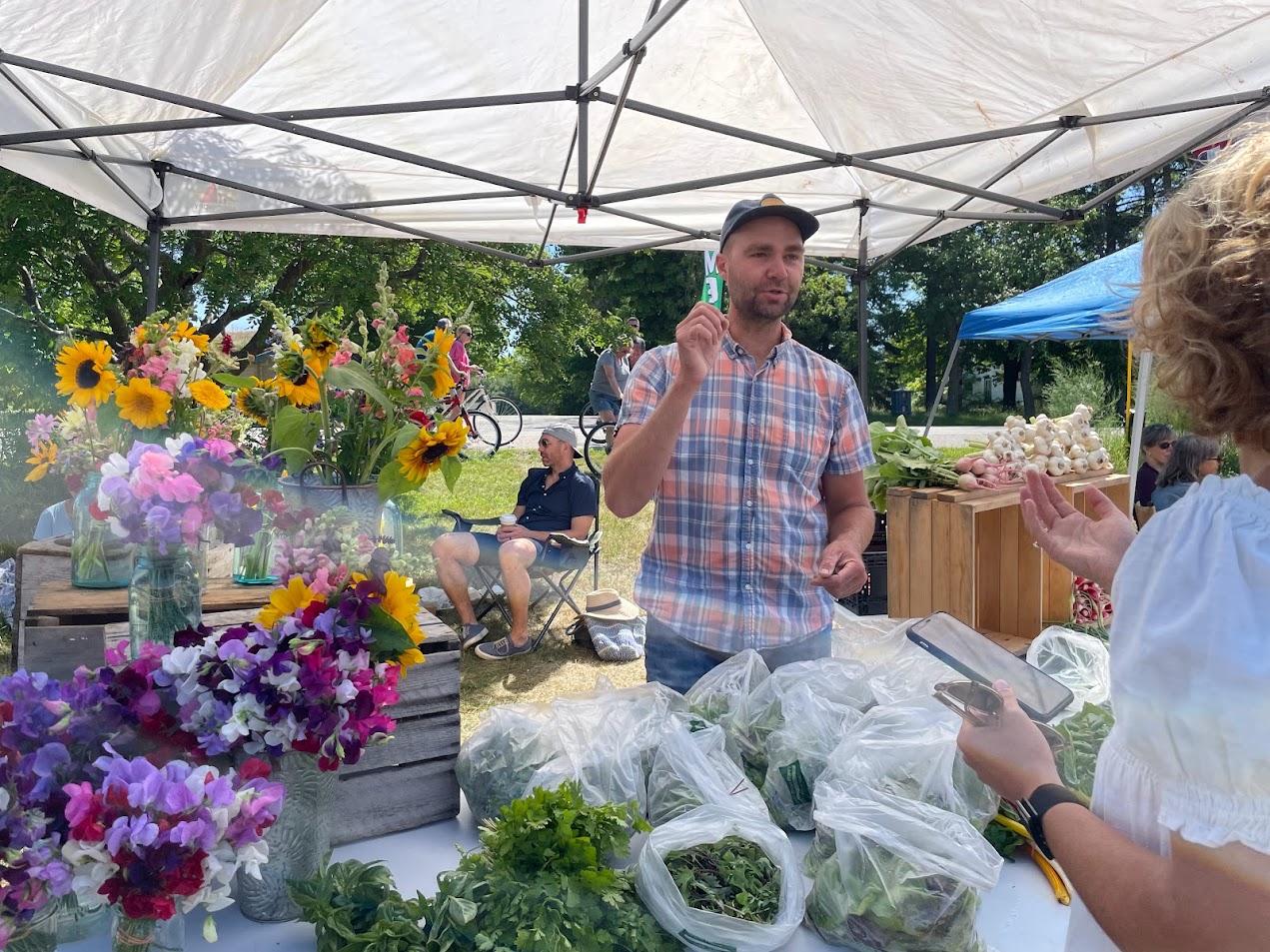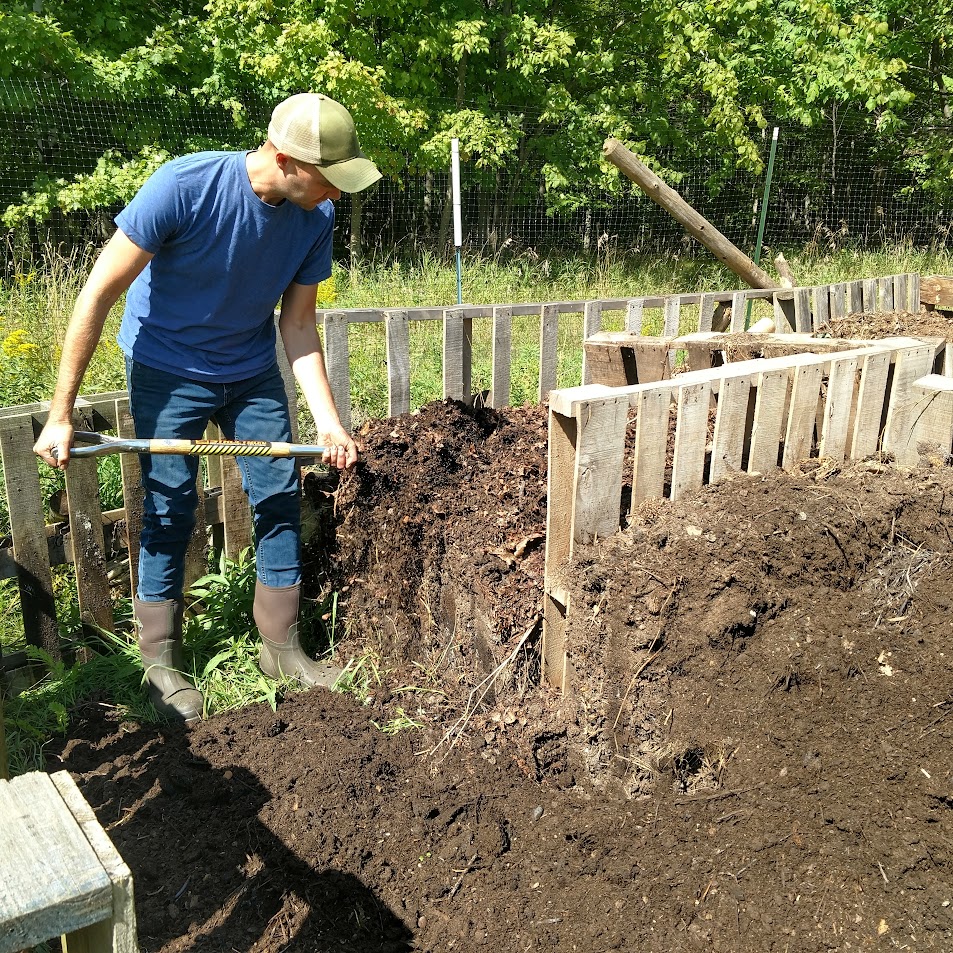by: Ronica Stromberg

Russell Rolffs sells directly to consumers on Washington Island, Wisconsin, where his micro farm is. “We know the community and the people we sell to, and I appreciate that aspect of it, just being connected to the people that find value in it,” he said.
CRAWL Growing Resilient Series:
Island Micro Farm Diversifies, Homes in on Soil Health for Resilience
For Russell Rolffs, farming success looks like 17 acres.
Rolffs and his wife, Alessandra, have run a micro farm for eight years on Washington Island, Wisconsin. He keeps fruit and chestnut orchards on 10 acres, a vineyard on five acres and vegetables and cut flowers on two acres. He also keeps a 30-by-90 greenhouse and sheep that help mow the orchards.
The couple sells only to a local restaurant and grocery store, at a farmers market and, for the flowers, at weddings because transporting products off the island is too costly.
“We're on an island and so we want to have a big diversity of things because, if we want to make a certain income for the farm, we really need to spread wider instead of go deeper on anything,” Rolffs said.
This farming concept differs from ones he grew up with near Pella, Iowa. There, his family raised cattle and pigs as well as corn and beans but had to give up raising livestock when they could no longer compete with larger confinement feed operations.
“The narrative there was not about their choices, but it was simplification, simplification, simplification, and that's the story for a lot of industrial agriculture,” he said. “I think my systems are different because I'm trying to get away from simplification and go to more diversification.”
Besides diverse crops and livestock, he said diversification could include practices such as rotating crops over time, planting multiple crops in one area, keeping livestock on cropland or rotating cropland into pastureland.
Rolffs said he has considered planting crops among his chestnut trees but harvesting the crops could be complex, as could the plant interactions. He has been thinking about plant synergies, what could be planted together to balance the agro-ecological system for maximal health of all the plants involved.
In his vegetable and flower gardens, he farms for long-term resilience by using cover crops and not tilling. He uses organic methods in the vineyard, rarely spraying and then only with organic sprays. If they have a pest outbreak on the vegetable and produce farm, they grow enough different plants that they generally let the pests be, he said.
“I'm not interested in producing food if part of that is producing pollutants that get into water systems and interrupt drinking water and health of wildlife habitats,” he said.
He said he thinks all farmers want to “do right” by the land and the people who eat their food but not all farming practices achieve the same results.
In the Midwest, farmers from his grandfather’s generation did not need to think as much about reducing tillage and keeping soil covered, he said, because the soil was good, they had diversification and animals grazed the land.
Simplifying to one or two crops and repeatedly using the land for just those crops can degrade soil over time, he said.
On Washington Island, farmers used to grow grains and potatoes but those were gone by the time Rolffs and his wife moved onto the island.
The vineyard was in place and mature, but grape diseases have posed challenges. Still, Rolffs said the sandy soil where the grapes grow and where he plants 50 chestnut trees every year is marginal agricultural land, best suited to the grapes and chestnuts. He does not irrigate.
He and his wife are making wine from the grapes and plan to start selling it this year to make the vineyard financially stable. The vegetable and flower gardens already turn a profit. The chestnut trees have begun producing nuts the couple plans to sell directly to consumers.
The fruit orchards have posed challenges similar to those of the grapes.
“Especially when you're doing it organically, it's at times very disabling and frustrating, but also, there's a lot of opportunity for creative thought and problem solving with that route as well, and that's just really fun for me,” he said.
The idea of designing farms different from the corn and bean farms of his childhood is what he said drew him back to farming after working several years as a high school teacher in English and math. He returned to farming with a strong interest in the horticulture side of it.
“I just came at it with a lot of different curiosities that go to a more holistic perspective on agriculture and how to design agricultural systems, farms, that are really biologically efficient, but maybe not very mechanistically efficient,” he said. “That side of agriculture just seemed like it had a lot more creativity to it, and that was really fun for me and really interesting to me and exciting to me.”
He is thinking about the long-term impact on soil when he harvests and defines resilience as connected to soil health.
“If I were to try to put metrics on it, I would look toward things like soil health and organic matter levels in my soil and evaluate my farming practices based on what's happening to my organic matter as I go,” he said. “Am I making it better or worse?”
The island has limestone soils that drain quickly and hold little moisture. He has found the soils may have great organic matter in the top few inches but not much below that.
Rolffs composts leaves and manure given to him by neighbors. The island doesn’t offer municipal leaf pickup. Each year, he makes about 15 yards of compost to add to his gardens to improve the soil.
After he has finished a crop for a season, he will add compost or undercomposted animal manures. He will sow a cover crop on top of the compost and grow grain.

On Washington Island, Russell Rolffs grows flowers and vegetables on his Hoot Blossom farm and educates the public about sustainable farming practices on his Gathering Ground vineyard and orchard. The island has shallow agricultural soils atop limestone. Rolffs composts leaves and other wastes and spreads the compost on his gardens to build up the soil prior to planting a crop or cover crop.
In the fall or winter, he puts dry mulch leaves or straw or, sometimes, silage tarps on the cover crop to kill it. The decaying cover crop will nourish the soil for his next round of planting.
He said he thinks the farms of the future will be more diversified, focus on metrics like soil health and involve thinking more holistically about the broader health of the land.
“The story of agriculture on the island is that it's been dead for 50 years already. I'm hoping for a rejuvenation of agriculture locally here on the island,” he said.
The island now has a farmers market, and he meets young people who want to get into agriculture. They express excitement about the increased regionalization of food systems.
“There is a lot of energy because it's the food people eat, and it's adding to and making more robust a local food culture that I think is an exciting transition,” he said.